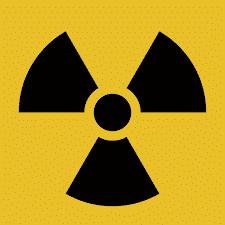News Alert — Jeff Rense’s show airs here! Go to Bob Nichols’ article. “Nichols on the Jeff Rense Show – GI’s Brains …”
(San Francisco) – Now it is official. Researchers have shown that uranium oxide, or DU, “travels the nerves from the nose to the brain,” in the words of a University of Chicago doc and researcher.

A tiny amount (a milligram) of this radioactive poison quick marches up your smelling nerves right into your brain and keeps firing 1.2 Million bullets a day – forever. That’s a bunch.
850 Rounds a Minute
The radioactive 850 rounds a minute automatic weapon is about as big as the period at the end of this sentence, never needs reloading and never jams. It’s a perfect killing machine for brain cells and other cells. The range is about 20 cells, after that there is what the famous British physicist Dr. Chris Busby calls the “bystander effect.” He discovered it, he gets to name it.
These radioactive automatic weapons are so small they can float right through your clothes, evade your skin’s defenses and invade your body. Wherever the weapons alight inside, there is trouble as they never stop firing and there is no limit to their number. In a soldiers brain, trouble shows up in a noticeable way to others.
As for the 20 cell radius ball within Range, think of these powerful Bullets each as a 100 car, 100 mph, or 160 kmh, fully loaded freight train obliterating a small dog tied to the railroad tracks. Right, for the 20 cells that are within range – in all directions, it ain’t pretty.
To me, this means these 20 cell radius spheres in Soldiers and Vets brains turn to jelly or mush, weird diseases or cancers, or all of the above. No wonder VA Secretary and former General Eric Shinseki has noted the big increase in the VA’s contract Psychiatric services.

This radioactive bullet explanation for Vets unusual behaviors holds water and makes perfect sense to me. The Vets are under attack internally. Actually inside their skulls and in their brains. Worse, there’s nothing they can do about it. The huge VA system is also helpless. There is no cure and no treatment.
The VA knows it and is stonewalling. They fired the only doc who stood up to them on DU. Word travels fast among the cowed medical staffs.
So, the Vets get slapped with some fake diagnosis and sent to the shrink or told there is nothing wrong with them. No way the spineless docs are going to call it like it is. They grab their 250K and slink home, comfortable every night.
That ain’t no way to run an Army; but, it IS a way to run the world’s most lethal Armed Force right into the ground.
Major Doug Rokke, Ph.D, Ret., former Director of the Pentagon’s Depleted Uranium Project, puts it succinctly “It [DU] is killing our own troops.”
General Eric Shinseki, Head of VA
Since no less than Gen Shinseki has pointed out the huge increases in contract psychiatric services, let’s all take note of it and ask real loud “Why is this happening to Vets? They are not the enemy!” It’s way past time to take names and kick ass in DC. That means changing the President as s/he appoints the head of the DOD. Not so hard to do, really. It is simply what is required.
No wonder DU in the brain drives Vets nuts. The suffering these Vets must go through is unimaginable.
OK. Here’s the targeted science, make up your own minds. I did.
Abstract
http://tinyurl.com/ku3ctn
Uranium travels nerves from nose to brain.
Jul 31, 2009
Tournier, BB, S Frelon, E Tourlonias, L Agez, O Delissen, I Dublineau, F Paquet, and F Petitot. 2009. Role of the olfactory receptor neurons in the direct transport of inhaled uranium to the rat brain. Toxicology Letters doi:10.1016/j.toxlet.2009.05.022.
Synopsis by Paul Eubig, DVM
Radioactive uranium that is inhaled by soldiers on the battlefield and by workers in factories may bypass the brain’s protective barrier by following nerves from the nose directly to the brain.
Nerves can act as a unique conduit, carrying inhaled uranium from the nose directly to the brain, finds a study with rats. Once in the brain, the uranium may affect task and decision-related types of thinking.
This study provides yet another example of how some substances can use the olfactory system – bypassing the brain’s protective blood barrier – to go directly to the brain. Titanium nanoparticles and the metals manganese, nickel, and thallium have been shown to reach the brain using the same route.
Military personnel and people who work in uranium processing plants are exposed to the weak radioactive element via wounds or by breathing. Exposure may affect brain function; cognitive skills are lowered in soldiers who carry uranium-laced shrapnel.
Uranium has various industrial and military uses. A form of uranium called depleted uranium is very dense and is used in armor-piercing ammunition and military vehicle armor.
Battlefield exposure can occur through wounds – such as with some US military personnel who were injured during the Gulf War. These exposures can be higher than with civilians who work with the element. A study of Gulf War veterans who have uranium shrapnel in their bodies showed that they perform more poorly on general brain cognitive tests of performance efficiency and accuracy.
Uranium can also be inhaled. Soldiers in vehicles hit by uranium rounds and workers in uranium-processing facilities can breathe it in.
The researchers – taking advantage of the fact that uranium can exist in different forms, or isotopes – used rats to compare how the element travels through the body if it is inhaled or injected into the blood. The animals breathed in one isotope at levels similar to those encountered on a battlefield where depleted uranium weapons are used. They were also injected with a different isotope. Researchers compared the levels of the two isotopes in different regions of the brain.
The inhaled isotope accumulated at 2 to 3 times higher levels than the injected isotope in the olfactory (smell) paths from the nose to the brain and in the frontal cortex and hypothalamus of the brain. This is concerning because the front part of the brain controls executive function, which is the broad ability to gather information, make decisions and initiate action.
The scientists then chemically damaged the olfactory nerves in the nose. The rats with the damaged nerves had three times less uranium in the olfactory system than the rats with intact olfactory nerves.
These finding suggests that inhaled uranium can travel directly from the nose along the olfactory nerves to the front of the brain. The olfactory pathway, then, plays an important role in inhaled uranium reaching the brain.
It is not known from this study if soldiers and civilian workers that breathe uranium could be at an even higher risk for cognitive effects or if inhaled uranium may affect brain function in similar ways as when it is carried through the blood. It is also unclear if these findings would hold true for the human brain since the rat brain is much more developed for smelling than the human brain.
Assessing these possible risks and determining if people’s relatively underdeveloped sense of smell could protect the brain would require further studies of people exposed to uranium through inhalation.
No 2.
Abstract
http://tinyurl.com/2ff6tcz
Uranium presents numerous industrial and military uses and one of the most important risks of contamination is dust inhalation. In contrast to the other modes of contamination, the inhaled uranium has been proposed to enter the brain not only by the common route of all modes of exposure, the blood pathway, but also by a specific inhalation exposure route, the olfactory pathway. To test whether the inhaled uranium enter the brain directly from the nasal cavity, male Sprague–Dawley rats were exposed to both inhaled and intraperitoneally injected uranium using the 236U and 233U, respectively, as tracers. The results showed a specific frontal brain accumulation of the inhaled uranium which is not observed with the injected uranium. Furthermore, the inhaled uranium is higher than the injected uranium in the olfactory bulbs (OB) and tubercles, in the frontal cortex and in the hypothalamus. In contrast, the other cerebral areas (cortex, hippocampus, cerebellum and brain residue) did not show any preferential accumulation of inhaled or injected uranium. These results mean that inhaled uranium enters the brain via a direct transfer from the nasal turbinates to the OB in addition to the systemic pathway. The uranium transfer from the nasal turbinates to the OB is lower in animals showing a reduced level of olfactory receptor neurons (ORN) induced by an olfactory epithelium lesion prior to the uranium inhalation exposure. These results give prominence to a role of the ORN in the direct transfer of the uranium from the nasal cavity to the brain.
http://tinyurl.com/2ff6tcz
[End]
The Notes are an integral part of the article. Include when distributing. CopyRight by Bob Nichols 2010. Feel free to distribute with attribution and Notes.
Related Articles.
“PTSD, infertility and other consequences of war,” April 27, 2010, Bob Nichols, VeteransToday dot com http://www.veteranstoday.com/2010/04/27/ptsd-infertility-and-other-consequences-of-war/ Or, http://tinyurl.com/22w8qpy
Notes:
“Uranium travels nerves from nose to brain.”
Synopsis by Paul Eubig, DVM Jul 31, 2009, Environmental Health News.
Role of the olfactory receptor neurons in the direct transport of inhaled uranium to the rat brain, Benjamin B. Tourniera, Sandrine Frelona, Elie Tourloniasa, Laurence Ageza, Olivia Delissena, Isabelle Dublineaub, François Paqueta and Fabrice Petitot, Institut de Radioprotection et de Sûreté Nucléaire, Laboratoire de Radiotoxicologie Expérimentale, IRSN/DRPH/SRBE/LRTOX, Site du Tricastin, B.P. 166, 26702 Pierrelatte Cedex, France, Institut de Radioprotection et de Sûreté Nucléaire, Laboratoire de Radiotoxicologie Expérimentale, IRSN/DRPH/SRBE/LRTOX, 92262 Fontenay-aux-Roses Cedex, France, Received 27 March 2009; revised 26 May 2009; accepted 27 May 2009. Available online 9 June 2009, Toxicology Letters Volume 190, Issue 1, 8 October 2009, Pages 66-73
“Sublethal Effects of Waterborne Uranium Exposures on the Zebrafish Brain: Transcriptional Responses and Alterations of the Olfactory Bulb Ultrastructure,” Ad†, Jean-Paul Bourdineaud‡, Karlijn van der Ven§, Tine Vandenbrouck§, Patrice Gonzalez‡, Virginie Camilleri†, Magali Floriani†, Jacqueline Garnier-Laplace† and Christelle Adam-Guillermin, Laboratoire de Radio
Environ. Sci. Technol., 2010, 44 (4), pp 1438–1443, DOI: 10.1021/es902550x, Publication Date (Web): January 20, 2010, Copyright © 2010 American Chemical Society
Google: uranium + olfactory For 102,000 responses with uranium and olfactory on the same page, Bob Nichols, Sep 29, 2010. Many will apply.
A second source for: “Role of the olfactory receptor neurons in the direct transport of inhaled uranium to the rat brain.” Toxicol Lett. 2009 Oct 8;190(1):66-73. Epub 2009 Jun 6.
http://www.ncbi.nlm.nih.gov/pubmed/19501638 http://tinyurl.com/24fljoc

Bob is a long-standing senior fellow with VT Foreign Policy since 2010. He is also a Project Censored Award winner, a former correspondent for the San Francisco Bay View newspaper, and a frequent contributor to various online publications.
He reports on war, politics, and the two nuclear weapons labs in the Bay Area. Nichols is writing a book based on 20 years of nuclear war in Central Asia. He is a former employee of an Army Ammunition Plant.
Follow Bob on his YouTube channel, Nichols on Nuclear, Twitter, and visit his website YourRadiationThisWeek.org.
You are encouraged to write Nichols at duweapons@gmail.com –
Visit Bob Nichol’s Latest Posts, Archives (2010-2015) – Archives (2016-2022)
ATTENTION READERS
We See The World From All Sides and Want YOU To Be Fully InformedIn fact, intentional disinformation is a disgraceful scourge in media today. So to assuage any possible errant incorrect information posted herein, we strongly encourage you to seek corroboration from other non-VT sources before forming an educated opinion.
About VT - Policies & Disclosures - Comment Policy



